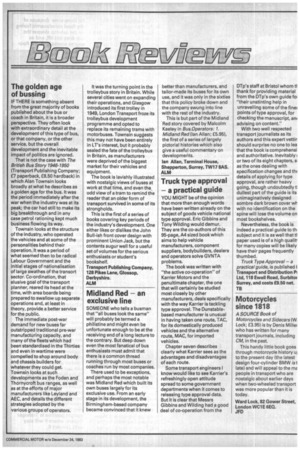The golden age of bussing
Page 23

If you've noticed an error in this article please click here to report it so we can fix it.
IF THERE is something absent from the great majority of books published about the bus or coach in Britain, it is a broader perspective. They often look with extraordinary detail at the development of this type of bus, or that company, or the other service, but the overall development and the inevitable impact of politics are ignored.
That is not the case with The British Bus Story 1946-1950 (Transport Publishing Company; E7 paperback, £8.50 hardback) in which Alan Townsin looks broadly at what he describes as a golden age for the bus. It was the period immediately after the war when the industry was at its peak; the car had still to make its big breakthrough and in any case petrol rationing kept much business flowing its way.
Townsin looks at the structure of the industry, who operated the vehicles and at some of the personalities behind their operation. It was a period of what seemed then to be radical Labour Government and the initial stages of nationalisation of large swathes of the transort sector. Co-ordination, that elusive goal of the transport planner, reared its head at the time, with area boards being prepared to swallow up separate operations and, at least in theory, provide a better service for the public.
The immediate post-war demand for new buses far outstripped traditional pre-war manufacturing capacity, and many of the fleets which had been standardised in the Thirties and even in wartime were compelled to shop around body and chassis builders for whatever they could get. Townsin looks at such developments as the Foden and Thornycroft bus ranges, as well as at the efforts of major manufacturers like Leyland and AEC, and details the different strategies adopted by the various groups of operators. It was the turning point in the trolleybus story in Britain. While several cities went on expanding their operations, and Glasgow introduced its first trolley in 1949, London Transport froze its trolleybus development programme and opted to replace its remaining trams with motorbuses. Townsin suggests this may not have been entirely in LT's interest, but it probably sealed the fate of the trolleybus in Britain, as manufacturers were deprived of the biggest market for their vehicles and equipment.
The book is lavishly illustrated with nostalgic views of buses at work at that time, and even the odd view of a tram to remind the reader that an older form of transport survived in some of its strongholds.
This is the first of a series of books covering key periods of the industry's development. One either likes or dislikes the John Bull-ish front cover design with prominent Union Jack, but the contents augur well for a useful set of volumes for the serious enthusiasts or student's bookshelf.
Transport Publishing Company, 128 Pikes Lane, Glossop, Derbyshire.
ALM




















































